Lyman Lake Petroglyphs And Famous Kokopelli-Flute Player Left By Ancestors Of The Hopi Indians
A. Sutherland - AncientPages.com - Lyman Lake petroglyphs can be found in Lyman Lake State Park, Arizona. Ancient rock art images are etched into boulders; they are numerous signs and symbols were left by ancients passing the area.
Most of the Lyman Lake rock art was created by pecking and no pictographs (paintings on rock) were found in the area. There are depictions of specific animals, masked figures, and a wide variety of geometric shapes.
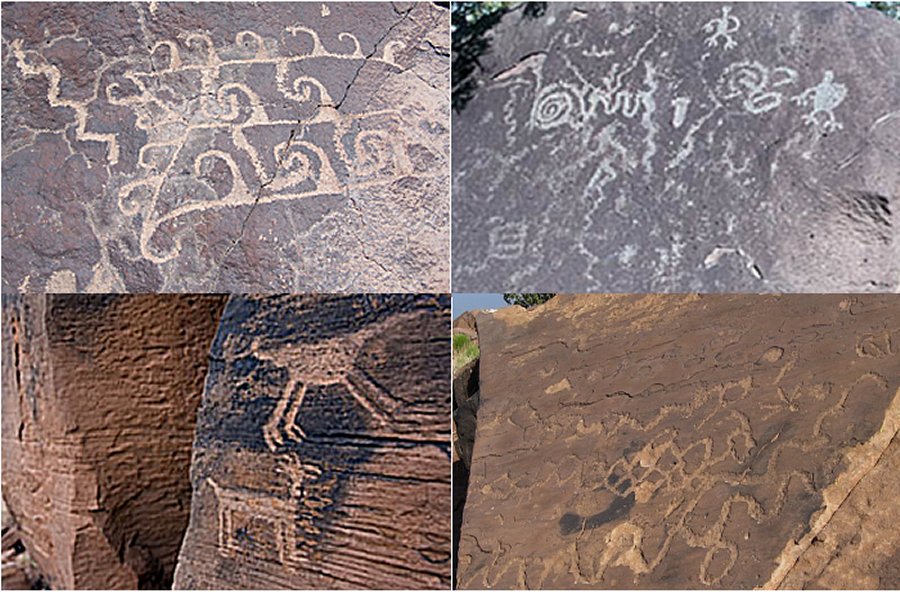
Hopi people interpret many of the petroglyphs in the Park as records of the migrations of their ancestors through this area. In many cases, the designs are associated with particular clans and events that took place during their migrations; others are clan symbols. Credits: Azcentral.com/Arizona State Parks
Archaeologists believe that the diversity of petroglyph styles indicates that more than one prehistoric culture made this rock art, but there is also a possibility that the style used by one culture changed through time.
The earliest petroglyphs in the Park are most probably dated from the Archaic (6000 BC to AD 300) and Basketmaker (from about AD 300 to 700) periods. Most of the petroglyphs date to the Pueblo periods (AD 700 through 1400), with the majority created during the final three centuries of
prehistoric occupation. Most recently, some archaeologists have begun to see petroglyphs as products of shamanistic rituals.
At Ultimate Rock, there is a large petroglyph-covered boulder but one of the most famous rock art in the area of Lyman Lake, Arizona is Kokopelli - a flute player. There are many stories about Kokopelli and he was not only a trickster god but also a fertility god, healer, and wonderful storyteller.
The Hopi were familiar with Kokopelli and he is mentioned in their migration and emergence account. According to the Hopi legend, when their people emerged into the Fourth World (our current world) they encountered an eagle that shot an arrow into insects that carried the power of heat.
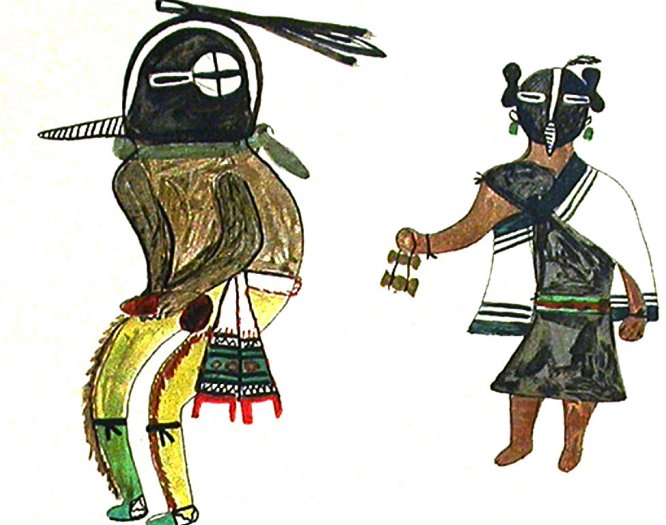
Kokopelli and Kokopelli Mana as depicted by the Hopi. Jesse Walter Fewkes, Hopi katcinas drawn by native artists, 1903 via Wikipedia
These insects known as máhus were not seriously harmed because as soon as they started to play on their flute, their bodies healed. The Hopi were accompanied by the two máhus on their migration.
One of these insects were called Kókopilau (kóko meaning “wood” and pilau meaning “hump”) because he looked like wood. He played on his flute and carried a bag of seed which he scarred across the lands. The wonderful music of his flute made the seeds grow.
The earliest petroglyphs in the Park date from the Archaic (6000 BC to 300 AD) and Basketmaker (from about 300 to 700 AD) periods. Most of the petroglyphs date to the Pueblo periods (700 through 1400 AD).
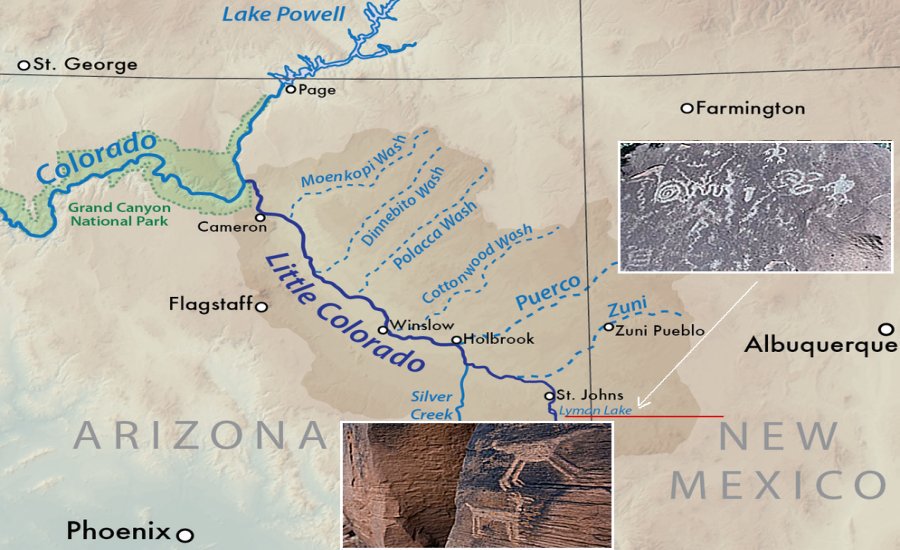
The prehistoric inhabitants of the upper Little Colorado River drainage left a rich material record of their time in the valley.
Some archaeologists associate the Lyman Lake rock art with shamanic rituals, but neither the Arizona State University's archaeologists nor the Hopi Indians agree with this theory. The ruined buildings, artifacts, and petroglyphs (“rock art”) provide the scientific evidence that permits archaeologists to understand the area’s history.
The pueblo ruins were built by ancestors of the Hopi Indians, who see the abandoned houses, broken pottery fragments, and markings on the rocks as a record left by their ancestors during the migrations described in Hopi oral tradition.
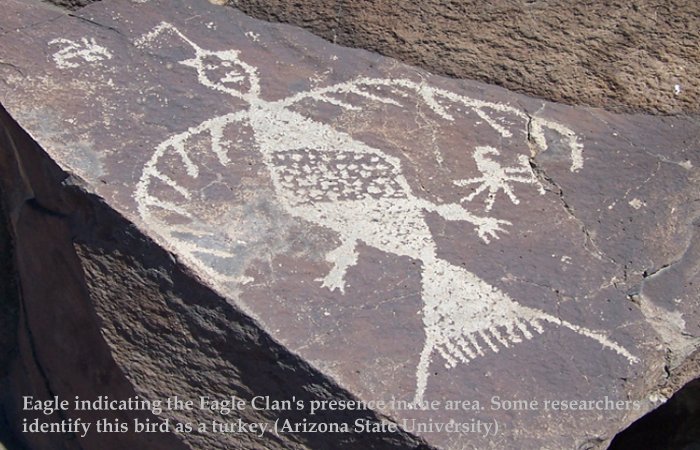
At Hopi, each clan has a narrative of its own history, from emergence, through migration, to eventual settlement on the Hopi mesas. Photo: Glyph Hunter
Created as an irrigation reservoir by damming the Little Colorado River, Lyman Lake State Park contains a number of pueblo ruins and rock art sites. Both Rattlesnake Point Pueblo and the Lyman Lake rock art site are important places for Hopi people. Hopi people consider these sites as homes of their ancestors during their migrations and the petroglyphs are these ancient people's signs.
In many cases, the designs are associated with particular clans and events that took place during their
migrations; others are clan symbols.
Written by – A. Sutherland - AncientPages.com Senior Staff Writer
Copyright © AncientPages.com All rights reserved. This material may not be published, broadcast, rewritten or redistributed in whole or part without the express written permission of AncientPages.com
Expand for referencesMore From Ancient Pages
-
 Ancient Inscriptions Of Babylonian King Nabonidus Discovered In Saudi Arabia
Archaeology | Jul 14, 2021
Ancient Inscriptions Of Babylonian King Nabonidus Discovered In Saudi Arabia
Archaeology | Jul 14, 2021 -
 Lofn ‘Matchmaker’ – Norse Goddess Of Forbidden Marriages Of People Who Wish To Be Loved And Search For Partners
Featured Stories | Mar 25, 2021
Lofn ‘Matchmaker’ – Norse Goddess Of Forbidden Marriages Of People Who Wish To Be Loved And Search For Partners
Featured Stories | Mar 25, 2021 -
 Historic Shipwreck Margaret A. Muir Found In Lake Michigan, Wisconsin
Archaeology | Jul 29, 2024
Historic Shipwreck Margaret A. Muir Found In Lake Michigan, Wisconsin
Archaeology | Jul 29, 2024 -
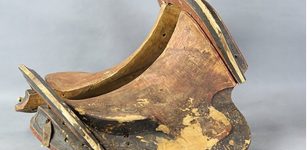 World’s Oldest Known ‘True’ Saddle Discovered In East Asia
Archaeology | Dec 11, 2023
World’s Oldest Known ‘True’ Saddle Discovered In East Asia
Archaeology | Dec 11, 2023 -
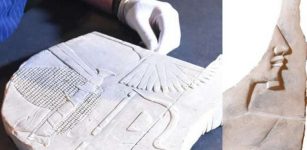 Mysterious Depiction Of Pharaoh Hatshepsut
Archaeology | May 17, 2018
Mysterious Depiction Of Pharaoh Hatshepsut
Archaeology | May 17, 2018 -
 Discovery Of Half-Million-Year-Old Wooden Structure Shows We’re Wrong To Underestimate Our Ancient Relatives
Featured Stories | Oct 10, 2023
Discovery Of Half-Million-Year-Old Wooden Structure Shows We’re Wrong To Underestimate Our Ancient Relatives
Featured Stories | Oct 10, 2023 -
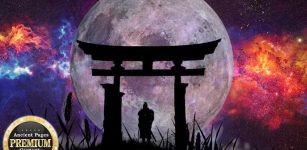 First Dream Of The New Year – Japanese Hatsuyume Tradition
Ancient Traditions And Customs | Jan 1, 2025
First Dream Of The New Year – Japanese Hatsuyume Tradition
Ancient Traditions And Customs | Jan 1, 2025 -
 On This Day In History: Michael Servetus Burned At The Stake ‘Atop A Pyre Of His Own Books’ – On Oct 27, 1553
News | Oct 26, 2016
On This Day In History: Michael Servetus Burned At The Stake ‘Atop A Pyre Of His Own Books’ – On Oct 27, 1553
News | Oct 26, 2016 -
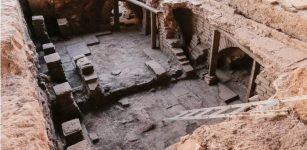 ‘Exceptional’ Ancient Roman Bath Complex Discovered In Mérida, Spain
Archaeology | Aug 21, 2023
‘Exceptional’ Ancient Roman Bath Complex Discovered In Mérida, Spain
Archaeology | Aug 21, 2023 -
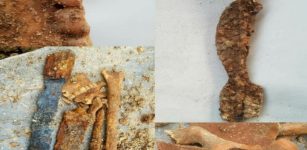 Ancient Tomb Chamber Of Parthian Warrior Was Accidentally Unearthed In Iran
Archaeology | Apr 30, 2020
Ancient Tomb Chamber Of Parthian Warrior Was Accidentally Unearthed In Iran
Archaeology | Apr 30, 2020 -
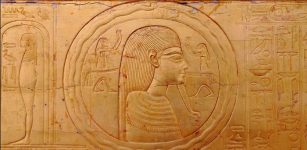 Ouroboros: Ancient Infinity Symbol Used By Different Ancient Civilizations
Ancient Symbols | Oct 3, 2017
Ouroboros: Ancient Infinity Symbol Used By Different Ancient Civilizations
Ancient Symbols | Oct 3, 2017 -
 The Helgö Treasure: Bronze Buddha Statue, Coptic Scoop And A Crozier Depicting Biblical Tale Of Jonah
Artifacts | Mar 10, 2023
The Helgö Treasure: Bronze Buddha Statue, Coptic Scoop And A Crozier Depicting Biblical Tale Of Jonah
Artifacts | Mar 10, 2023 -
 Mystery Of Arthur’s Stone In UK – Solved?
Archaeology | Aug 11, 2021
Mystery Of Arthur’s Stone In UK – Solved?
Archaeology | Aug 11, 2021 -
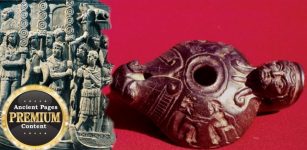 Mysterious Ancient Oil Lamps In Ohio And Wisconsin – Evidence Of Pre-Columbian Contact?
Ancient Mysteries | Dec 20, 2017
Mysterious Ancient Oil Lamps In Ohio And Wisconsin – Evidence Of Pre-Columbian Contact?
Ancient Mysteries | Dec 20, 2017 -
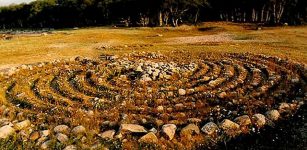 Secrets Of Bolshoi Zayatsky Island – Mysterious Stone Labyrinths Of Unknown Purpose And Origin
Featured Stories | Oct 21, 2014
Secrets Of Bolshoi Zayatsky Island – Mysterious Stone Labyrinths Of Unknown Purpose And Origin
Featured Stories | Oct 21, 2014 -
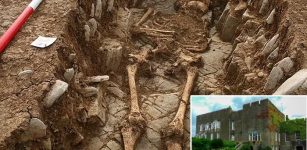 Mysterious Medieval Cemetery In Wales With People Buried In Unusual Positions Puzzles Archaeologists
Archaeology | Jan 3, 2024
Mysterious Medieval Cemetery In Wales With People Buried In Unusual Positions Puzzles Archaeologists
Archaeology | Jan 3, 2024 -
 Wonderful And Unique Viking Silver Treasure Uncovered In Täby In Stockholm, Sweden
Archaeology | Nov 29, 2022
Wonderful And Unique Viking Silver Treasure Uncovered In Täby In Stockholm, Sweden
Archaeology | Nov 29, 2022 -
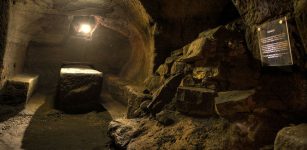 Gilmerton Cove: Mysterious Cave System Still Keeps Its Centuries-Old Secrets
Featured Stories | Nov 27, 2021
Gilmerton Cove: Mysterious Cave System Still Keeps Its Centuries-Old Secrets
Featured Stories | Nov 27, 2021 -
 60-Meter Longhouse Discovered Near Viking Ship At Gjellestad, Norway
Archaeology | Dec 6, 2021
60-Meter Longhouse Discovered Near Viking Ship At Gjellestad, Norway
Archaeology | Dec 6, 2021 -
 Sculpture Of Lord Vishnu Dated To The Early 9th Century Found In Kashmir
Archaeology | Aug 4, 2022
Sculpture Of Lord Vishnu Dated To The Early 9th Century Found In Kashmir
Archaeology | Aug 4, 2022

